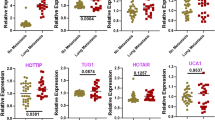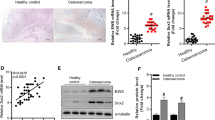Abstract
Metastasis-associated lung adenocarcinoma transcript 1 (MALAT1), one of the first found cancer-associated long noncoding RNAs (lncRNAs), involves in the development and progression of many types of tumors. An aberrant expression of MALAT1 was observed in hepatocellular carcinoma, cervical cancer, breast cancer, ovarian cancer, and colorectal cancer. However, the exact effects and molecular mechanisms of MALAT1 in osteosarcoma progression are still unknown up to now. Here, we investigated the role of MALAT1 in human osteosarcoma cell lines and clinical tumor samples in order to determine the function of this molecule. In our research, the MALAT1 messenger RNA (mRNA) was highly expressed in human osteosarcoma tissues, and its expression level was closely correlated with pulmonary metastasis. Then, we employed lentivirus-mediated knockdown of MALAT1 in U-2 OS and SaO2 to determine the role of MALAT1 in osteosarcoma cell lines. Lentivirus-mediated MALAT1 small interfering RNA (siRNA) could efficiently downregulated the expression level of MALAT1 in osteosarcoma cell lines. Knockdown of MALAT1 inhibited the proliferation and invasion of human osteosarcoma cell and suppressed its metastasis in vitro and vivo. At the same time, the proliferating cell nuclear antigen (PCNA), matrix metallopeptidase 9 (MMP-9), phosphorylated PI3Kp85α, and Akt expressions were significantly inhibited in MALAT1-deleted cells. These findings indicated that MALAT1 might suppress the tumor growth and metastasis via PI3K/AKT signaling pathway. Taken together, our data indicated that MALAT1 might be an oncogenic lncRNA that promoted proliferation and metastasis of osteosarcoma and could be regarded as a therapeutic target in human osteosarcoma.





Similar content being viewed by others
References
Huang J, Ni J, Liu K, Yu Y, Xie M, Kang R, et al. HMGB1 promotes drug resistance in osteosarcoma. Cancer Res. 2012;72:230–8.
Clark JC, Dass CR, Choong PF. A review of clinical and molecular prognostic factors in osteosarcoma. J Cancer Res Clin Oncol. 2008;134:281–97.
Meyers PA, Schwartz CL, Krailo MD, Healey JH, Bernstein ML, Betcher D, et al. Osteosarcoma: the addition of muramyl tripeptide to chemotherapy improves overall survival—a report from the Children’s Oncology Group. J Clin Oncol. 2008;26:633–8.
Rinn JL, Chang HY. Genome regulation by long noncoding RNAs. Annu Rev Biochem. 2012;81:145–66.
Mattick JS. The genetic signatures of noncoding RNAs. PLoS Genet. 2009;5:e1000459.
Gutschner T, Hammerle M, Diederichs S. MALAT1—a paradigm for long noncoding RNA function in cancer. J Mol Med (Berl). 2013;91:791–801.
Ji P, Diederichs S, Wang W, Boing S, Metzger R, Schneider PM, et al. MALAT-1, a novel noncoding RNA, and thymosin beta4 predict metastasis and survival in early-stage non-small cell lung cancer. Oncogene. 2003;22:8031–41.
Yamada K, Kano J, Tsunoda H, Yoshikawa H, Okubo C, Ishiyama T, et al. Phenotypic characterization of endometrial stromal sarcoma of the uterus. Cancer Sci. 2006;97:106–12.
Brauze D, Mikstacka R, Pelkonen O. Monoclonal antibody characterization of NADH- and NADPH-dependent hydroxylation of benzo(a)pyrene in liver microsomes from 5,6-benzoflavone-induced C57Bl/6 mice. Acta Biochim Pol. 1990;37:219–25.
Lin R, Maeda S, Liu C, Karin M, Edgington TS. A large noncoding RNA is a marker for murine hepatocellular carcinomas and a spectrum of human carcinomas. Oncogene. 2007;26:851–8.
Feng J, Tian L, Sun Y, Li D, Wu T, Wang Y, et al. Expression of long non-coding ribonucleic acid metastasis-associated lung adenocarcinoma transcript-1 is correlated with progress and apoptosis of laryngeal squamous cell carcinoma. Head Neck Oncol. 2012;4:46.
Sun Y, Wu J, Wu SH, Thakur A, Bollig A, Huang Y, et al. Expression profile of microRNAs in c-Myc induced mouse mammary tumors. Breast Cancer Res Treat. 2009;118:185–96.
Hutchinson JN, Ensminger AW, Clemson CM, Lynch CR, Lawrence JB, Chess A. A screen for nuclear transcripts identifies two linked noncoding RNAs associated with SC35 splicing domains. BMC Genomics. 2007;8:39.
Gupta RA, Shah N, Wang KC, Kim J, Horlings HM, Wong DJ, et al. Long non-coding RNA HOTAIR reprograms chromatin state to promote cancer metastasis. Nature. 2010;464:1071–6.
Ji Q, Zhang L, Liu X, Zhou L, Wang W, Han Z, et al. Long non-coding RNA MALAT1 promotes tumour growth and metastasis in colorectal cancer through binding to SFPQ and releasing oncogene PTBP2 from SFPQ/PTBP2 complex. Br J Cancer. 2014;111:736–48.
Lai MC, Yang Z, Zhou L, Zhu QQ, Xie HY, Zhang F, et al. Long non-coding RNA MALAT-1 overexpression predicts tumor recurrence of hepatocellular carcinoma after liver transplantation. Med Oncol. 2012;29:1810–6.
Ying L, Chen Q, Wang Y, Zhou Z, Huang Y, Qiu F. Upregulated MALAT-1 contributes to bladder cancer cell migration by inducing epithelial-to-mesenchymal transition. Mol Biosyst. 2012;8:2289–94.
Taniguchi M, Fujiwara K, Nakai Y, Ozaki T, Koshikawa N, Toshio K, et al. Inhibition of malignant phenotypes of human osteosarcoma cells by a gene silencer, a pyrrole-imidazole polyamide, which targets an E-box motif. FEBS Open Bio. 2014;4:328–34.
Gutschner T, Diederichs S. The hallmarks of cancer: a long non-coding RNA point of view. RNA Biol. 2012;9:703–19.
Fellenberg J, Bernd L, Delling G, Witte D, Zahlten-Hinguranage A. Prognostic significance of drug-regulated genes in high-grade osteosarcoma. Mod Pathol. 2007;20:1085–94.
Edmondson HA, Steiner PE. Primary carcinoma of the liver: a study of 100 cases among 48,900 necropsies. Cancer. 1954;7:462–503.
Hong SK, Yoon S, Moelling C, Arthan D, Park JI. Noncatalytic function of ERK1/2 can promote Raf/MEK/ERK-mediated growth arrest signaling. J Biol Chem. 2009;284:33006–18.
Zhang Y, Sun S, Chen J, Ren P, Hu Y, Cao Z, et al. Oxymatrine induces mitochondria dependent apoptosis in human osteosarcoma MNNG/HOS cells through inhibition of PI3K/Akt pathway. Tumour Biol. 2014;35:1619–25.
Yuan SX, Yang F, Yang Y, Tao QF, Zhang J, Huang G, et al. Long noncoding RNA associated with microvascular invasion in hepatocellular carcinoma promotes angiogenesis and serves as a predictor for hepatocellular carcinoma patients’ poor recurrence-free survival after hepatectomy. Hepatology. 2012;56:2231–41.
Birney E, Stamatoyannopoulos JA, Dutta A, Guigo R, Gingeras TR, Margulies EH, et al. Identification and analysis of functional elements in 1 % of the human genome by the encode pilot project. Nature. 2007;447:799–816.
Wu XS, Wang XA, Wu WG, Hu YP, Li ML, Ding Q, et al. MALAT1 promotes the proliferation and metastasis of gallbladder cancer cells by activating the ERK/MAPK pathway. Cancer Biol Ther. 2014;15:806–14.
Jin S, Pang RP, Shen JN, Huang G, Wang J, Zhou JG. Grifolin induces apoptosis via inhibition of PI3K/AKT signalling pathway in human osteosarcoma cells. Apoptosis. 2007;12:1317–26.
Liu B, Shi ZL, Feng J, Tao HM. Celecoxib, a cyclooxygenase-2 inhibitor, induces apoptosis in human osteosarcoma cell line MG-63 via down-regulation of PI3K/Akt. Cell Biol Int. 2008;32:494–501.
Conflicts of interest
None
Author information
Authors and Affiliations
Corresponding authors
Additional information
Yongqiang Dong and Guojun Liang contributed equally to this work.
Rights and permissions
About this article
Cite this article
Dong, Y., Liang, G., Yuan, B. et al. MALAT1 promotes the proliferation and metastasis of osteosarcoma cells by activating the PI3K/Akt pathway. Tumor Biol. 36, 1477–1486 (2015). https://doi.org/10.1007/s13277-014-2631-4
Received:
Accepted:
Published:
Issue Date:
DOI: https://doi.org/10.1007/s13277-014-2631-4




